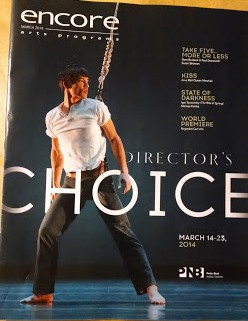 In my review of Pacific Northwest Ballet’s 2014 Director’s Choice program on Monday I wrote:
In my review of Pacific Northwest Ballet’s 2014 Director’s Choice program on Monday I wrote:
I could say so much more about “State of Darkness” … this piece set off bottle rockets in my brain and it will probably take a while to make sense from all the patterns.
My mind has been churning on this dance since I saw it last week, and although I have yet to make sense of all the patterns, I need to say so much more about it.
Molissa Fenley
According to choreographer Molissa Fenley, she was so taken with Stravinsky’s “Rite of Spring” she began using it when she practiced. Her routine evolved into a dynamic solo that explores themes of fear, animal presence, and the shift from power to loss of self-control.
When Fenley presented the ballet in 1988, she faced predictable gender-based criticism; not only was she considered arrogant for breaking free of ensemble dance and performing her own choreography solo, but the dance was “unfeminine.” It was powerful, aggressive, and violent. Further, Fenley herself appeared androgynous dressed in black tights and with a short haircut.
Gender Binary
At Pacific Northwest Ballet, the soloist is male, but none of the uneasiness of blurred gender lines is lost. Instead, the flowing, gentle parts of the dance stand out. The dancer skips in circles around the stage with windmilling arms, and eyebrows shoot up in the darkness. Like the music, which evokes both the soft warmth of spring and its freezing storms, “State of Darkness” teeters between strength and grace. Grace and strength are required of every ballet dancer. But visually, grace is almost always expressed by female dancers, while strength is represented by the male dancers. Because there is only one dancer, this piece will always include parts that are unsettling.
The Dancer
At PNB, Principal Jonathan Poretta is the usual performer. I saw the dance at a matinee, when Matthew Renko, pulled from the corps de ballet, danced. I was reminded of those TV episodes that presage a spin-off – with only about half a dozen dancers in the world having learned “State of Darkness,” this solo must be a career-defining moment for Renko.
Although “State of Darkness” has a lot in common with “Mopey” (a single dancer in a minimal costume on a starkly lit stage with no sets), Mopey is only 15 minutes long. The dancer in “Darkness” must hold the audience’s attention for a grueling 36 minutes of highly technical dance. Renko glistened with sweat visible from the second balcony. But the only time he showed even a hint of strain was when his legs seemed to shiver during a long-held eagle pose about 20 minutes into the performance. That was about the same time I started to feel lightheaded and realized that I had forgotten to breathe.
Well, here I am, over 700 words and almost a week later. I’m still making new observations, stumbling on new insights, but no closer to resolving “State of Darkness.” Is there anything more satisfying than discovering a piece of art that perplexes you, that captures your mind and won’t let go?




About the author